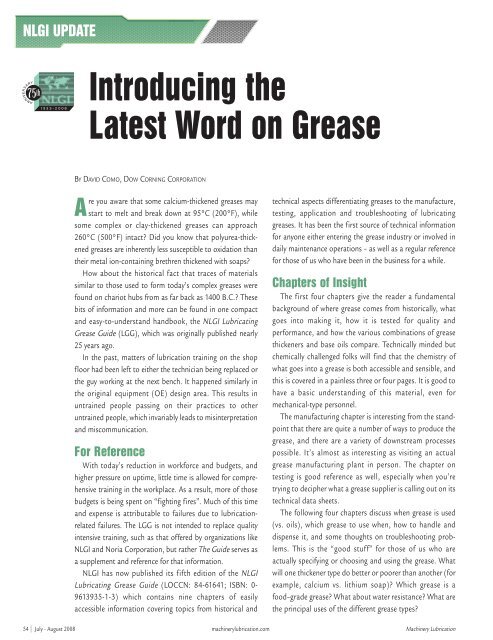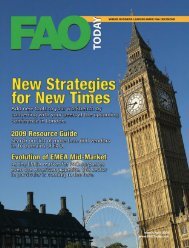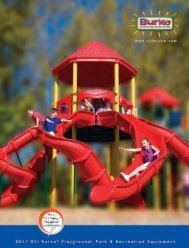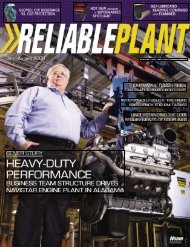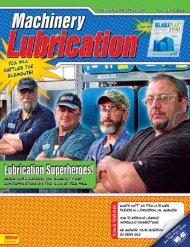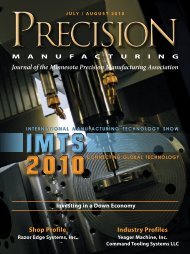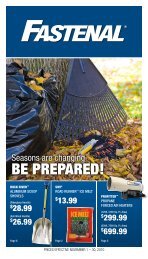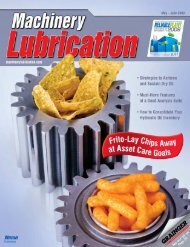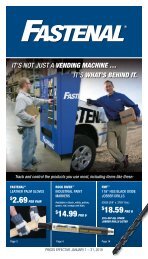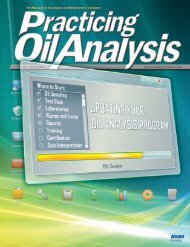Machinery Lubrication July August 2008
Machinery Lubrication July August 2008
Machinery Lubrication July August 2008
You also want an ePaper? Increase the reach of your titles
YUMPU automatically turns print PDFs into web optimized ePapers that Google loves.
NLGI UPDATE<br />
Introducing the<br />
Latest Word on Grease<br />
BY DAVID COMO, DOW CORNING CORPORATION<br />
Are you aware that some calcium-thickened greases may<br />
start to melt and break down at 95°C (200°F), while<br />
some complex or clay-thickened greases can approach<br />
260°C (500°F) intact? Did you know that polyurea-thickened<br />
greases are inherently less susceptible to oxidation than<br />
their metal ion-containing brethren thickened with soaps?<br />
How about the historical fact that traces of materials<br />
similar to those used to form today’s complex greases were<br />
found on chariot hubs from as far back as 1400 B.C.? These<br />
bits of information and more can be found in one compact<br />
and easy-to-understand handbook, the NLGI Lubricating<br />
Grease Guide (LGG), which was originally published nearly<br />
25 years ago.<br />
In the past, matters of lubrication training on the shop<br />
floor had been left to either the technician being replaced or<br />
the guy working at the next bench. It happened similarly in<br />
the original equipment (OE) design area. This results in<br />
untrained people passing on their practices to other<br />
untrained people, which invariably leads to misinterpretation<br />
and miscommunication.<br />
For Reference<br />
With today’s reduction in workforce and budgets, and<br />
higher pressure on uptime, little time is allowed for comprehensive<br />
training in the workplace. As a result, more of those<br />
budgets is being spent on “fighting fires”. Much of this time<br />
and expense is attributable to failures due to lubricationrelated<br />
failures. The LGG is not intended to replace quality<br />
intensive training, such as that offered by organizations like<br />
NLGI and Noria Corporation, but rather The Guide serves as<br />
a supplement and reference for that information.<br />
NLGI has now published its fifth edition of the NLGI<br />
Lubricating Grease Guide (LOCCN: 84-61641; ISBN: 0-<br />
9613935-1-3) which contains nine chapters of easily<br />
accessible information covering topics from historical and<br />
technical aspects differentiating greases to the manufacture,<br />
testing, application and troubleshooting of lubricating<br />
greases. It has been the first source of technical information<br />
for anyone either entering the grease industry or involved in<br />
daily maintenance operations – as well as a regular reference<br />
for those of us who have been in the business for a while.<br />
Chapters of Insight<br />
The first four chapters give the reader a fundamental<br />
background of where grease comes from historically, what<br />
goes into making it, how it is tested for quality and<br />
performance, and how the various combinations of grease<br />
thickeners and base oils compare. Technically minded but<br />
chemically challenged folks will find that the chemistry of<br />
what goes into a grease is both accessible and sensible, and<br />
this is covered in a painless three or four pages. It is good to<br />
have a basic understanding of this material, even for<br />
mechanical-type personnel.<br />
The manufacturing chapter is interesting from the standpoint<br />
that there are quite a number of ways to produce the<br />
grease, and there are a variety of downstream processes<br />
possible. It’s almost as interesting as visiting an actual<br />
grease manufacturing plant in person. The chapter on<br />
testing is good reference as well, especially when you’re<br />
trying to decipher what a grease supplier is calling out on its<br />
technical data sheets.<br />
The following four chapters discuss when grease is used<br />
(vs. oils), which grease to use when, how to handle and<br />
dispense it, and some thoughts on troubleshooting problems.<br />
This is the “good stuff” for those of us who are<br />
actually specifying or choosing and using the grease. What<br />
will one thickener type do better or poorer than another (for<br />
example, calcium vs. lithium soap)? Which grease is a<br />
food–grade grease? What about water resistance? What are<br />
the principal uses of the different grease types?<br />
54 <strong>July</strong> - <strong>August</strong> <strong>2008</strong> machinerylubrication.com <strong>Machinery</strong> <strong>Lubrication</strong>


